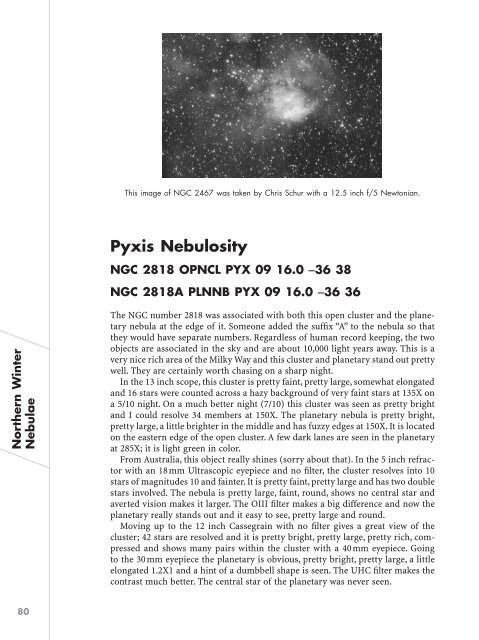Nebulae and How to Observe Them
Nebulae and How to Observe Them
Nebulae and How to Observe Them
You also want an ePaper? Increase the reach of your titles
YUMPU automatically turns print PDFs into web optimized ePapers that Google loves.
Northern Winter<br />
<strong>Nebulae</strong><br />
80<br />
This image of NGC 2467 was taken by Chris Schur with a 12.5 inch f/5 New<strong>to</strong>nian.<br />
Pyxis Nebulosity<br />
NGC 2818 OPNCL PYX 09 16.0 -36 38<br />
NGC 2818A PLNNB PYX 09 16.0 -36 36<br />
The NGC number 2818 was associated with both this open cluster <strong>and</strong> the planetary<br />
nebula at the edge of it. Someone added the suffix “A” <strong>to</strong> the nebula so that<br />
they would have separate numbers. Regardless of human record keeping, the two<br />
objects are associated in the sky <strong>and</strong> are about 10,000 light years away. This is a<br />
very nice rich area of the Milky Way <strong>and</strong> this cluster <strong>and</strong> planetary st<strong>and</strong> out pretty<br />
well. They are certainly worth chasing on a sharp night.<br />
In the 13 inch scope, this cluster is pretty faint, pretty large, somewhat elongated<br />
<strong>and</strong> 16 stars were counted across a hazy background of very faint stars at 135X on<br />
a 5/10 night. On a much better night (7/10) this cluster was seen as pretty bright<br />
<strong>and</strong> I could resolve 34 members at 150X. The planetary nebula is pretty bright,<br />
pretty large, a little brighter in the middle <strong>and</strong> has fuzzy edges at 150X. It is located<br />
on the eastern edge of the open cluster. A few dark lanes are seen in the planetary<br />
at 285X; it is light green in color.<br />
From Australia, this object really shines (sorry about that). In the 5 inch refrac<strong>to</strong>r<br />
with an 18mm Ultrascopic eyepiece <strong>and</strong> no filter, the cluster resolves in<strong>to</strong> 10<br />
stars of magnitudes 10 <strong>and</strong> fainter. It is pretty faint, pretty large <strong>and</strong> has two double<br />
stars involved. The nebula is pretty large, faint, round, shows no central star <strong>and</strong><br />
averted vision makes it larger. The OIII filter makes a big difference <strong>and</strong> now the<br />
planetary really st<strong>and</strong>s out <strong>and</strong> it easy <strong>to</strong> see, pretty large <strong>and</strong> round.<br />
Moving up <strong>to</strong> the 12 inch Cassegrain with no filter gives a great view of the<br />
cluster; 42 stars are resolved <strong>and</strong> it is pretty bright, pretty large, pretty rich, compressed<br />
<strong>and</strong> shows many pairs within the cluster with a 40mm eyepiece. Going<br />
<strong>to</strong> the 30mm eyepiece the planetary is obvious, pretty bright, pretty large, a little<br />
elongated 1.2X1 <strong>and</strong> a hint of a dumbbell shape is seen. The UHC filter makes the<br />
contrast much better. The central star of the planetary was never seen.











